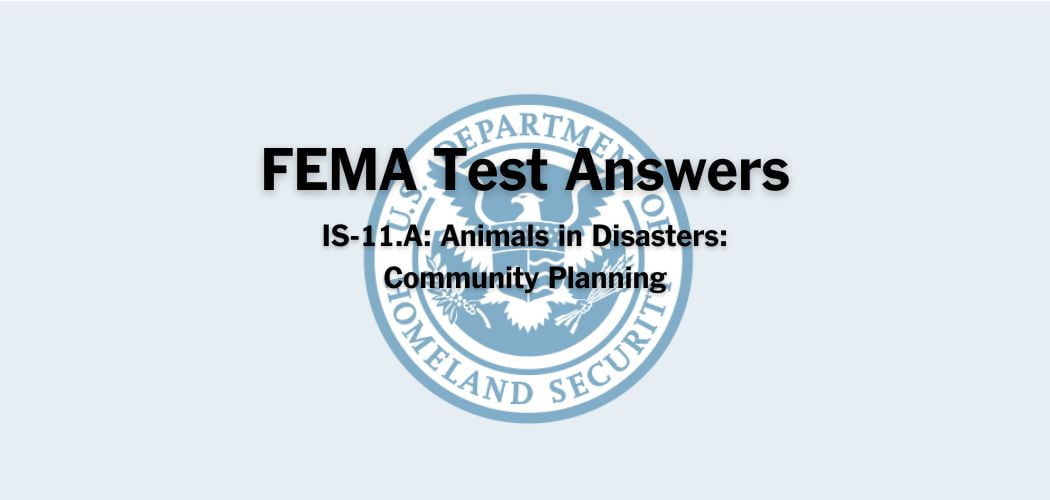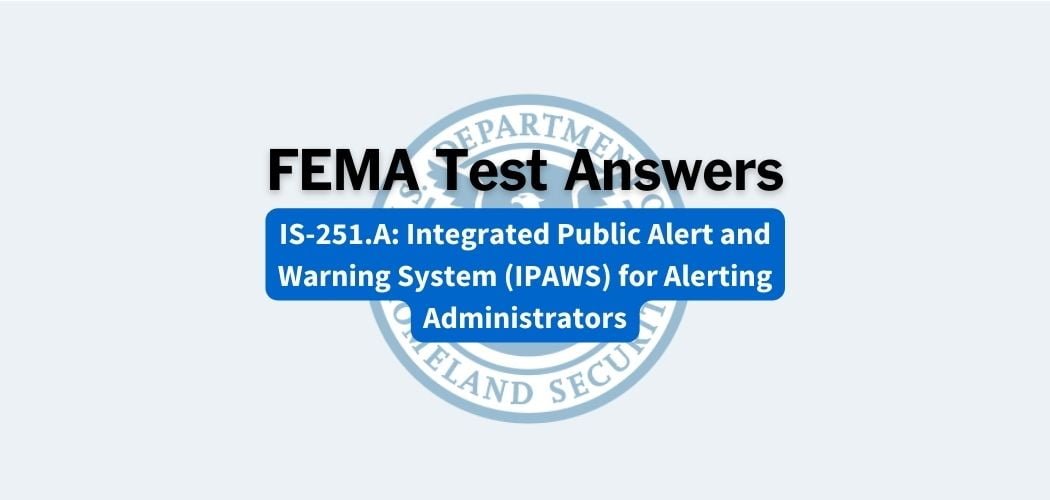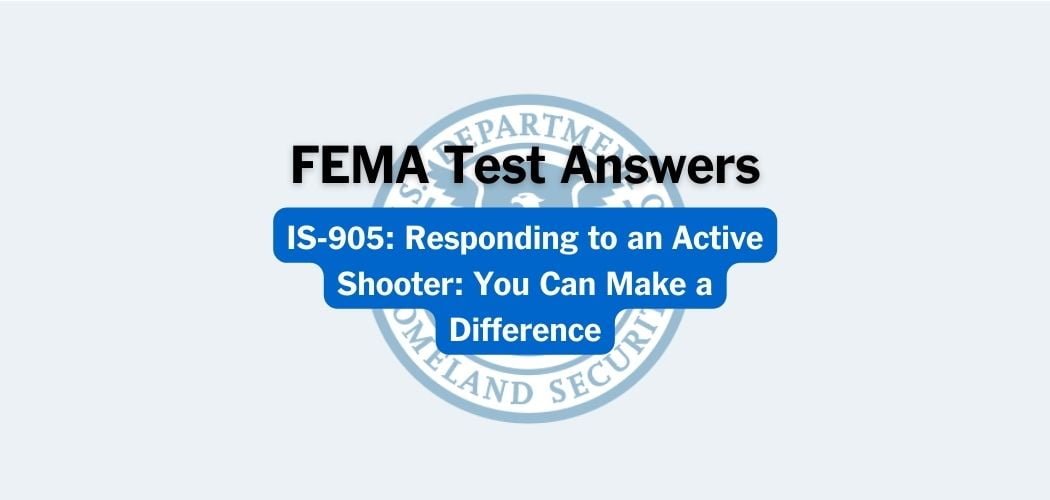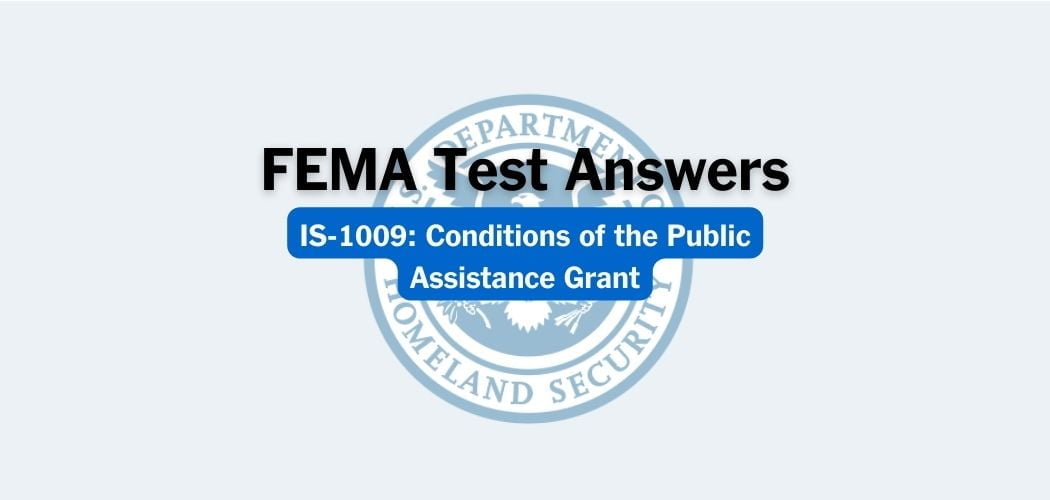Overview: The new FEMA IS-35 course was last updated on January 4, 2024 to help you understand your safety rights and responsibilities and what you can do to safeguard your well-being on the job — both in your regular workplace and during deployments.
FEMA IS-35 is also designed to help you understand your safety rights and responsibilities and what you can do to safeguard your well-being on the job — both in your regular workplace and during deployments.
FEMA IS-35 test answers
Each time this test is loaded, you will receive a unique set of questions and answers. The test questions are scrambled to protect the integrity of the exam.
Question 1. Staying safe during deployment requires preparation and planning. The following preparatory steps can help you stay safe during deployment. (Select the missing action.)
– Find out the local conditions before you go so you can pack the proper clothing and gear.
– Make sure your inoculations are up to date.
– Monitor local broadcasts for local weather and road closings.
– _______.
A. Save time by leaving home as soon as you learn of the disaster instead of waiting to be deployed.
B. After planning your travel route, watch for shortcuts you can take to get to your destination more quickly.
C. If driving in storm-impacted areas, plan to do most of your driving at night when there is less traffic.
D. Before setting out in a rental car, make sure you have gas, food, water, and safety supplies for 24 to 48 hours.✅
Question 2. All of the following are good safety practices in the workplace EXCEPT:
A. Wash your hands frequently by rubbing them for 10 to 15 seconds with plenty of soap and warm water.
B. Prop open the emergency exit door while moving boxes in and out of the stairwell.✅
C. Eat nutritious foods, drink plenty of non-caffeinated, non-alcoholic fluids, and take rest breaks when possible.
D. Keep workspaces tidy by closing file drawers and cupboard doors and returning tools and supplies to their proper places.
Question 3. TRUE or FALSE: When working in cold temperatures, if your fingers become whitish and very painful, you should immediately run them under hot water and rub them vigorously.
A. TRUE
B. FALSE✅
Question 4. When working in hot weather, it is a good practice to:
A. Apply sunscreen of SPF 15 or higher 30 minutes before going out.✅
B. Do most of your outdoor work between 11 a.m. and 2 p.m.
C. Wear dark-colored, tight-fitting clothing to regulate body temperature.
D. Limit your fluid intake to ice water and high-sugar drinks.
Question 5. Which of the following statements is CORRECT?
A. If a hotel fire alarm goes off, your first action should be to open your room door and see if there is fire or smoke in your hallway.
B. When deployed, it is safe to ignore the frequent loss of temper, inability to sleep, and loss of appetite because they are natural responses to disaster recovery work.
C. During deployment, you should wear your FEMA badge displayed prominently on your outer clothing when you leave the facility.
D. Stress and fatigue may compromise your safety by decreasing your ability to concentrate and make decisions, slowing your reaction time, and causing accidents.✅
Question 6. You are driving through a storm-damaged area when you see a downed power line lying flat across the road about 20 feet in front of you. The road is wet but not underwater. The best course of action would be to:
A. Back up cautiously until you can turn around and drive away from the area.✅
B. Get out of the car to get a closer look so you can assess the danger.
C. Drive very slowly over the power line and continue on.
D. Stay inside the car and call the electric company to find out if the wire has power.
Question 7. If you are involved in an accident while driving a Government vehicle (GSA, rental, or personal vehicle while on officially sanctioned FEMA business), follow these guidelines: (Select the missing action.)
– Check for personal injuries and get help if needed.
– Exchange information with the other driver.
– Make the required notifications. For proof of insurance, check the glove compartment or rental contract.
– _______.
A. Submit an accident report on form SF91.
B. Get the names and contact information of witnesses.
C. Contact your personal insurance company.
D. Take photographs or make a diagram of the accident scene.✅
Question 8. You are working around damaged buildings and debris piles in an area where poisonous snakes and spiders are known to be present. In this situation, it is a good practice to:
A. Assume buildings are stable unless they are marked otherwise.
B. Wear short sleeves to avoid becoming overheated.
C. Wear light footwear, such as athletic shoes, for maximum agility.
D. Use long-handled tools when removing debris.✅
Question 9. To keep your back healthy and pain-free, you should take the following common sense safety precautions. (Select the additional item.)
– Minimize reaching by keeping frequently used items within arm’s reach.
– Keep your back in shape with regular stretching exercises.
– Get help from a coworker or use a hand truck if the load is too heavy or bulky to lift alone.
– _______.
A. Hold the object being lifted at arm’s length away from your body.
B. Avoid overextending by standing up when retrieving objects on shelves.✅
C. Lift heavy items off the floor by bending at the waist.
D. Use your feet to push heavy objects rather than trying to lift them.
Question 10. Review the statements below and select the TRUE statement:
A. If you notice that the extension cord you are using is damaged, you should unplug it and repair it with electrical tape before using it with office equipment.
B. It is safe to remove the grounding prong from an electrical cord if you are going to plug it into a two-prong outlet.
C. The all-purpose cleaner comes in a big, heavy jug. You should pour the cleaner into several empty, discarded water bottles to avoid lifting too heavy of an object.
D. Aerosol cans should be kept away from open flames, hot surfaces, electrical and mechanical sparks, and static electricity.✅
Question 11. TRUE or FALSE: Hypothermia can occur even at temperatures above 40°F if you become chilled from rain, sweat, or submersion in cold water.
A. TRUE✅
B. FALSE
Question 12. At a JFO, who has primary responsibility for conducting incident-specific briefings on potential hazards for those working in the field?
A. Joint Field Office Chief of Staff
B. Joint Field Office Safety Official✅
C. Joint Field Office Planning Section Chief
D. Joint Field Office Human Resources Unit Leader
Question 13. TRUE OR FALSE: An Executive Order prohibits Federal employees from engaging in text messaging when driving on official Government business or when using electronic equipment supplied by the Government while driving.
A. TRUE✅
B. FALSE
Question 14. You are working on the fifth floor of a building when an alarm sounds and an evacuation notice is given. All of the following are recommended safe practices EXCEPT:
A. Go to your emergency assembly point and report in.
B. Secure your computer and work materials before leaving.
C. Use the nearest elevator to exit the building quickly.✅
D. Account for any visitors and guide them to the assembly point.
Question 15. The Occupational Safety and Health Act of 1970 requires:
A. Employees are to submit to random drug screening and other annual health examinations.✅
B. Employers to provide workplaces that are free from serious recognized hazards.
C. Employees to purchase protective equipment required to perform assigned job duties.
D. Employers to make reasonable accommodations for employees with disabilities.
Question 16. Which of the following is a TRUE statement about sheltering in place?
A. When a shelter-in-place notice is given, you should follow instructions from the Occupant Emergency Team, moving to an alternate interior location if directed.✅
B. Sheltering in place is typically used in the case of a building fire, so you should activate the nearest fire alarm as you leave your workstation.
C. As you move toward a shelter-in-place location, you should stay near exterior walls and windows and open as many interior doors as possible.
D. Sheltering in place is intended as a long-term response, so you should take sufficient work materials with you to stay busy for several days.
Question 17. You are working in a Joint Field Office following a major earthquake and continuing aftershocks. You notice that the exit sign near your office is broken and no longer illuminates. What should you do?
A. Do internet research to determine if an illuminated sign is required for safety.
B. Open the sign and see if it needs a new bulb.
C. Put up hand-made signs pointing the way to the exit.
D. Report the hazard to your supervisor.✅
Other recurring FEMA courses
These courses currently have a “calendar-year” extension to allow FEMA staff to retake the course as a recurring requirement.
- IS-18.24: FEMA EEO Employee Course 2024
- IS-19.24: FEMA EEO Supervisor Course 2024
- IS-20.24: Diversity Awareness Course 2024
- IS-21.24: Civil Rights and FEMA Disaster Assistance
- IS-37.24: Managerial Safety and Health
- IS-107.24: FEMA Travel Rules and Regulations 2024
- IS-246.24: Implementing the Federal Priorities and Allocations System (FPAS)



